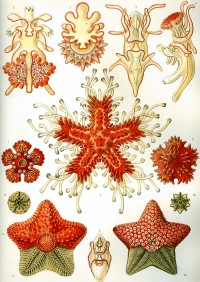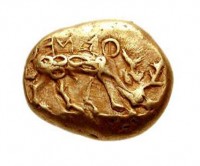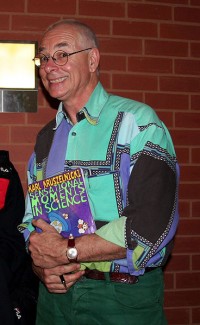Good Grief, Skip! Murder, Mourning, or Anthropomorphism?

Giving Skippy human like expressions and agency was more fantasy than fact.
If you’re over the age of thirty and grew up in Australia, there’s a good chance you know who Skippy is. This famous kangaroo—a friend ever true—was the Aussie equivalent of Lassie, forever helping her human companion, Sonny Hammond, get in and out of trouble.
With their upright stance and small hands, kangaroos are readily anthropomorphised. That is to say, it’s easy to attribute kangaroos with human-like traits. Just recently, a heart-breaking story of a kangaroo mourning a lost companion did the rounds through Australian social media. Photographer Evan Switzer chanced upon a dying female kangaroo being cradled in the forearms of a male, a small joey standing nearby.
“He would lift her up and she wouldn’t stand she’d just fall to the ground, he’d nudge her, stand besides her…it was a pretty special thing, he was just mourning the loss of his mate,” Evan was reported saying in the Daily Mail.
Only the kangaroo wasn’t mourning for its departed mate. It was…well, for a lack of a better term, turned on. Sexually. And might have even been the murderer.
CONTINUE READING THIS POST…
A History of Life’s Vital Essence (Part 3): The Twilight of Vitalism

Image by Daniel Loxton and Jim W. W. Smith.
Vitalism died a death of a thousand cuts. There was no single experiment, no one find that falsified the idea. Rather it was a shadow that shrank as the light of discovery grew.
One such event has become legendary in most modern science classrooms. In the late 18th century Italian physician Luigi Galvani was said to have brushed the sciatic nerve a frog he was dissecting with his metal instruments in such a way to cause the legs to twitch. This observation, it’s said, led to his research into connections between the emerging field of electrochemistry and physiology.
Galvani’s ‘electrical fluid’ theory paved the way for understanding how nervous impulses stimulate muscle movement, removing the need for some vague impetus or desire for movement.
TAGS: belief, biology, history, Intelligent Design, philosophy, pseudoscience, science, vitalismA History of Life’s Vital Essence (Part 2): Vital Thinking
This post continues a three-part series exploring the history of vitalism. Read Part 1 and continue on to Part 3.

A depiction of Paracelsus. This image was copied from a lost original which may have been painted from life. (Via Wikimedia Commons.)
The 16th century Swiss-German physician and alchemist Theopharastus von Honhenheim—better known as Paracelsus—saw little distinction between his studies in chemistry and medical biology. Famous for his quote on all things being poisons, Paracelsus believed chemistry lay at the heart of health and disease. Given the relationship between contemporary medicines and toxicology, with many treatments based on substances such as alcohol, arsenic, antimony, lead and mercury, it’s surprising his position wasn’t more widely held.
TAGS: belief, biology, Descartes, history, Intelligent Design, Paracelsus, philosophy, pseudoscience, science, vitalismA History of Life’s Vital Essence (Part 1): Fire and Gods

One of biology’s longest standing mysteries was explaining how complex life emerged from simpler chemical structures.
When the 19th century German embryologist Wilhelm Roux looked down the microscope at a frog’s egg, he saw a machine. A tiny, perfect molecular machine with chemical cogs and atomic gears. Life was analogically—indeed, almost literally—based on complex organic machinery. “Lehre von den Ursachen der organischen Gestaltungen,” he wrote[1]. Developmental mechanics is the cause of the organic form.
But Wilhelm had a rather big problem to solve. Cells reproduce by splitting in half before growing. Divide a machine and all you get is two simpler machines, each with half of their original pieces. How does something grow in complexity as its components seem to grow in simplicity?
The answer wouldn’t come for half a century. In the meantime, an old fashioned belief in ghostly forces would have one last opportunity to prove itself worthy of being considered scientific.
TAGS: belief, biology, hans driesch, history, Intelligent Design, philosophy, pseudoscience, science, vitalism, wilhelm rouxA Token Thought for the Ancient Seeds of Science

Coins entered the world of ancient Greece by the 6th century BCE, shortly followed by the first material philosophers. (Image by Classical Numismatic Group, Inc., via Wikimedia Commons, used under Creative Commons Attribution-Share Alike 3.0 Unported license.)
Precisely when the guttural croaks and screeching hoots of ancient humans became words is a mystery. We do know language can be measured in hundreds of thousands, if not millions of years—that is, humans have been physiologically capable of sharing observations about their surroundings for a long time. For most of history, the stories we shared have described a universe that is personal, emotional, and whimsical.
Then, about two and a half thousand years ago, something different happened. On the coast of modern day Turkey in a city called Miletus, a man named Thales wondered what everything in nature was made of. His answer was almost mundane: water.
It’s unlikely Thales of Miletus was the first to consider this question, nor the first to suggest an answer. Since none of his writings have survived the ages we are forced to rely on writers like Aristotle and Herodotus to speculate on the thoughts of this so-called ‘first philosopher’. But Thales represented the emergence of a way of thinking new in human history, where the universe emerges from a single system of impersonal qualities.
TAGS: behavioral psychology, brain, coins, culture, evolution and/or creationism, history of science, science, science philosophyBeware the Dystopian Visions of Celebrity Scientists

Stephen Hawking’s future: doomed singularity or invading aliens? Image by J. Nathan Matias, via Wikimedia Commons Commons. Used under Creative Commons Attribution-NonCommercial 2.0 Generic license.
Several years ago, eminent British cosmologist Professor Stephen Hawking made headlines by speculating that first contact with sentient aliens probably wouldn’t end in high-fives and tribble-cuddles. “If aliens visit us, the outcome would be much as when Columbus landed in America, which didn’t turn out well for the Native Americans,” he suggested.
As if that rosy idea wasn’t enough, Professor Hawking has now claimed the invention of artificial intelligence (AI) could precipitate the end of humanity. “It would take off on its own, and re-design itself at an ever increasing rate,” he recently told the BBC. “Humans, who are limited by slow biological evolution, couldn’t compete, and would be superseded.”
Intergalactic robots landing on his lawn must surely be nightmare-fuel.
It’s easy to dismiss the famous author’s pessimism as the harmless speculation of a respected intellectual (or, for those inclined, to accept his opinions with alarm). Yet given the challenges involved in engaging the public in the realities of science, the sci-fi musings of a world famous scientist might be less than helpful.
TAGS: artificial intelligence, consciousness, psychology, science, singularity, Stephen HawkingNext Gen Dr Karl? Not Me

Karl Kruszelnicki at a University of Sydney event in 2006. Image by Enoch Lau, via Wikimedia Commons. Used under Creative Commons Attribution-Share Alike 3.0 Unported license.
On the back of a book I wrote a few years ago is a blurb describing me as “the next generation Dr Karl”. Flattering, but I really hate that comparison. Not because I hate Dr Karl—who happens to be fantastic promoter of science—but because if it’s one thing the world doesn’t need, it’s one more wacky science communicator in a bright Hawaiian shirt.
Publishers love a hook for the reader. And since Dr Karl Kruszelnicki is arguably Australia’s most recognisable science writer, it makes sense that his name would be used to promote a science book written by a nobody like me.
I had the pleasure of interviewing Dr Karl for Skepticality in 2008, and have spoken to him once or twice since. His personality is as bright as his wardrobe, and if you have a science question he’ll undoubtedly have a quirky, fascinating story to respond with. (He’s especially generous about answering questions on Twitter.) He certainly presents a lot for a science personality to aspire to, and I have much admiration for the man.
Beyond sharing a love of science story-telling, though, our similarities are few. I wouldn’t be caught dead in a colour brighter than khaki green. I have piercings and a few tattoos, and usually take great pains to avoid describing myself as geeky. I also do my best to correct anybody giving me a PhD (one I never earned), and I don’t call myself a scientist since I haven’t run an assay or poked at a patient in years. Dr Karl I ain’t.
TAGS: science, science communicationScience On the Edge of Life

Is anybody still at home when the lights go out?
—Wikimedia Commons/Jens Maus BY-SA
“Death does not concern us, because as long as we exist, death is not here,” said that ancient hero of hedonism and Athenian party animal, Epicurus. “And when it does come, we no longer exist.”
For some, this is of great comfort. The idea of eternity—even if it’s spent watching seasons two to infinite of Firefly—is not everybody’s cup of cocoa. For others, it’s impossible to contemplate our minds ever processing a final thought. A recently published study titled “AWAreness during REsuscitation” has reignited the discussion of what happens to our minds as we die.
TAGS: awareness during resuscitation, medicine, mortality, near-death experiencesBrand Name Science
“Next time you catch a taxi, and you’re talking about your day,” said my old boss. “Tell them our story. Tell them about how we developed the polymer bank notes, or about our role in developing wi-fi. Tell them about the exciting research we’re doing in astronomy, or in healthcare.”
The intention was for us to play our role in advertising the relevance of this prominent Australian research organisation to the average person, of course. Market research indicated that in spite of being relatively well known as far as Australian science research went, brand recognition was underwhelming in some key demographics. Primarily among the younger generations. Sharing our organisation’s stories with random strangers was a personal way we employees could all do our bit.
If we were selling merchandise in a free market, advertising a brand would be par for the course. Selling science, however, isn’t quite the same thing, is it?
TAGS: ALS, ice bucket challenge, science branding, science funding









